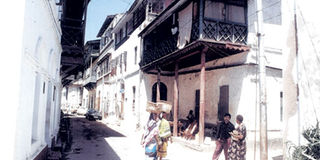Manbasa, Mombaz, Mvita? It’s a mix of histories for coast city

PHOTO | FILE The first recorded mention of Mombasa is in the works of Diogenes, a Greek merchant of the First Century.
What you need to know:
- Most European travellers referred to the town as “Mombaz” or close forms of the word
As the country’s oldest city and its most important port, Mombasa holds a central place in Kenya’s story.
The city’s history dates back thousands of years, and is riddled with violent conflict, numerous takeovers, and an enduring cultural impact.
The earliest recorded mention of Mombasa is in the works of Diogenes, a Greek merchant in the First Century. Diogenes reported that he had been blown off course from his usual route to India, ending up in a port town he called Rhapta.
Rhapta has never been conclusively identified, but Roman coins have been found on several islands that were part of or near what became the Zanzibar Sultanate, of which Mombasa was a core town.
The island was first referred to as ‘‘Manbasa’’ in 1502, when the Sultanate became autonomous from Kilwa Kisiwani. ‘‘Manbasa’’ is the Arabic form of the Kiswahili name, Mvita, derived from Shehe Mvita, the founding father of the island city.
Some sources claim that Mvita is actually derived from Mombasa’s violent history over the centuries. The history supposedly earned the city the Kiswahili nickname “Kisiwa Cha Mvita”, which loosely translates to “Island of War”.
Most European travellers referred to it as “Mombaz” or close forms of the word. While it was a British Protectorate for two short years between 1824 and 1826, Mombasa was turned over fully to the British Imperial East African Company in 1898.
The Sultan of Zanzibar officially leased the town to the British government in 1895 as a follow-up to an 1885 agreement. Technically, and legally, the coastal strip that is today the Kenyan coastline remained part of Zanzibar until it was ceded to independent Kenya in 1963.
Another famous town at the coast, Voi, derives its name from the legendary slave trader, Chief Kivoi, who settled near Voi River with his people. The resulting settlement retained the last syllable of his name.
It is also roughly around the area that Kivoi and Ludwig Krapf were attacked by bandits, who fatally wounded the Kamba chief. Chief Kivoi is also the man credited with giving, albeit indirectly, Kenya its modern name when he showed Ludwig Krapf Mount Kenya and referred to it as “Kiima kia Nyaa”.
Mariakani, another town on the route to the coast, derives its modern name from the spot where long distance traders would leave their bows and arrows before entering Mombasa.
The Sultan had banned traders from entering the town with any weapons. One theory suggests that the ban was the result of several fatal brawls between Kamba traders and coastal residents.
The place, thus, became known as Riaka, the Duruma name for a single quiver, or Mariaka, its plural form. The Giriama and the Kamba word for quiver is Thyaka (singular). They called the place ‘“Mathyakani”. Mariakani thus translates directly to “the place of Quivers” in the Duruma language.
Travellers to and from coast through that trade route would say they were going to “Mariakani” to drop off or collect their weapons.
They needed the weapons along the route to fight off bandits, maintain discipline within their own ranks, and protect themselves from wild animals, such as the lions of Tsavo.
A leather quiver that was common among the traders can be found at the Kenya National Archives.




